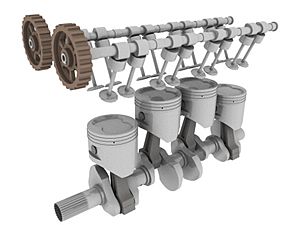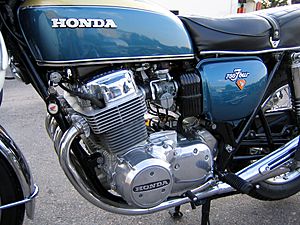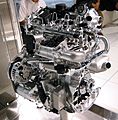Inline-four engine facts for kids

An inline-four engine (also called a straight-four engine) is a type of internal combustion engine. This means it burns fuel inside to create power. It has four cylinders arranged in a straight line. These cylinders are all connected to one crankshaft, which is a spinning rod that helps move the car. These engines can run on different fuels like gasoline, diesel, or natural gas.
The cylinders can be placed straight up (vertically) or at an angle. If they are angled, it's sometimes called a slant-four engine. When you see it written as a short form, it's usually I4 or L4. The 'L4' is often used to make sure people don't confuse the letter 'I' with the number '1'.
The inline-four engine is quite simple in its design. It naturally has a good balance, making it smoother than engines with one, two, or three cylinders. This is why it's a popular choice for many everyday cars. However, it can have small vibrations, especially as the engine gets bigger and more powerful. Larger cars often use different engine designs to avoid these stronger vibrations.
Engine Size (Displacement)
The inline-four gasoline engine is very common in cars with an engine size (called displacement) up to about 2.4 liters. Some sports cars, like the Porsche 944 S2 and 968, even used a 3.0-liter four-cylinder engine. Older cars, like the Model A Ford, also had larger inline-four engines (around 3.3 liters) to make enough horsepower and torque.
Diesel inline-four engines usually spin slower than gasoline engines. They often have sizes bigger than 3.0 liters. For example, Toyota made a 4.1-liter diesel engine for its Mega Cruiser. Even larger four-cylinder engines, up to about 4.6 liters, are used in industrial machines. On the other hand, some cars sold in Japan have very small engines, only 660 cubic centimeters (cc).
Used in Racing
In 1913, the Indianapolis 500 race was won by Jules Goux in a Peugeot car. This car had an inline-four engine designed by Ernest Henry. This engine was very important for racing. It was one of the first to use special parts called dual overhead camshafts (DOHC) and four valves per cylinder. This design soon became the standard for many racing inline-four engines.
Later, an American driver named "Wild Bob" Burman bought this Peugeot car. When its engine broke in 1915, he asked Harry Arminius Miller to build a new one. Miller, along with John Edward and Fred Offenhauser, created a new engine based on the Peugeot design. This engine, first called Miller and later Offenhauser, became very famous. It won many Indianapolis 500 races, even five in a row from 1971 to 1976! It wasn't until the 1980s that other engines, like the Cosworth V8 engine, took over.
Many race cars built before WWII for Grand Prix races also used inline-four engines. These cars were often fixed up and used again after the war. They helped start what we now know as Formula One racing.
Used in Motorcycles
Inline-four engines became very popular in modern motorcycles after Honda released its CB750 in the 1970s. This engine had a single overhead camshaft. Today, the inline-four is one of the most common engine types for street bikes. This is because they offer good performance for their cost. All the major Japanese motorcycle makers sell bikes with inline-four engines.
Images for kids
-
The engine of a Ford Model T (1908–1941).
See also
 In Spanish: Motor de cuatro cilindros en línea para niños
In Spanish: Motor de cuatro cilindros en línea para niños









